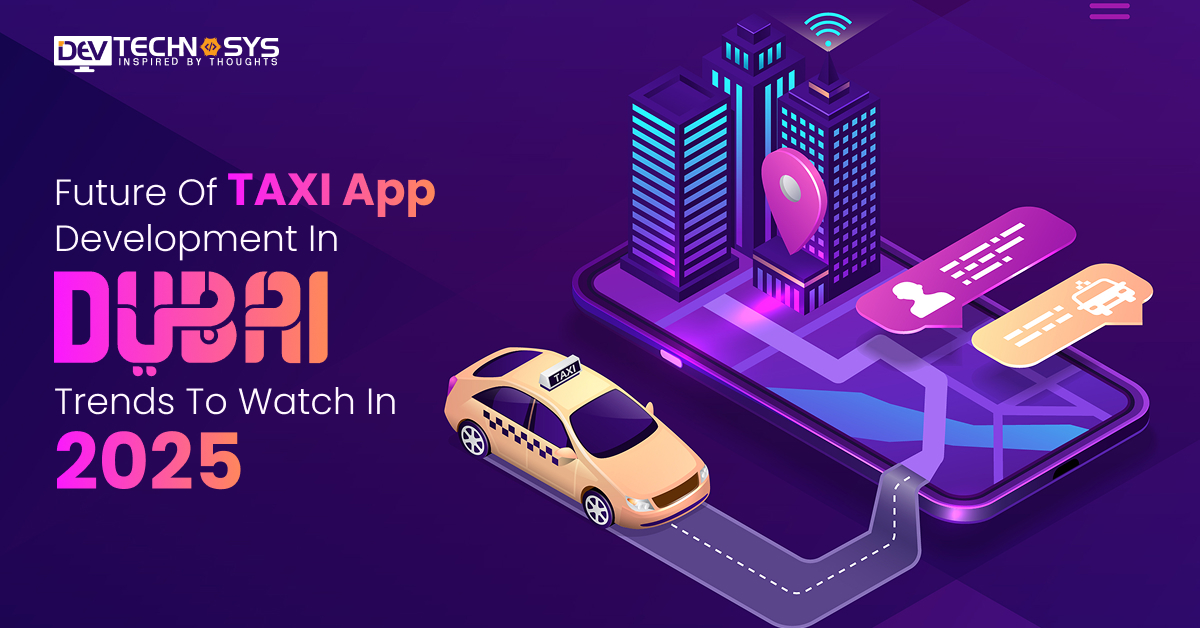“Get access to modern taxi app development trends for your business growth.”
Are you looking to transform your caravan into an online taxi marketplace? Start investing in the UAE market to experience budget-friendly taxi app development services for creating smart and reliable taxi booking solutions. Dubai and other cities offer varied models helping businesses to easily target specific audiences for delivery of services.
The idea to develop a taxi app for local and visitors in Dubai, is perfect for small and medium-sized businesses. There are several trends active in the UAE market that involve the latest technologies which allow mobile app development.
So, let’s study them in this blog along with other topics like market presence, various taxi brands, and challenges.
Current Taxi Industry Market
With digital ride-hailing services gaining a greater share, the UAE taxi industry is changing quickly. The industry is expanding gradually as businesses are investing money to create a taxi app. Urbanization and smartphone penetration is increasing, due to integration of taxi app development services in UAE with new technology and sustainable business models. This satisfies growing customer demands and environmental regulations.

- UAE Online Taxi Market: Valued at $324.14 Million, projected to reach $415.07 Million by 2029 with a rate of 4.25% CAGR.
- Dubai Ride‑Hailing: Generated approx. $194.8 Million in revenue, expected to grow to $254.5 Million by 2029 at a rate of 5.29% CAGR.
- Middle East & Africa Ride‑Hailing: Market size of $4.42 Billion, forecasted to reach $9.99 Billion with a rate of 8.5% CAGR by 2033.
- Dubai Taxi Revenue: Approximately $160 Million, up 7% YoY, with 86% fleet hybrid/electric.
- UAE Shared Mobility: Growing at a rate of 25.1% CAGR, led by shared rides and eco-friendly transport solutions.
How the Taxi Industry Evolved?
The taxi business has experienced a significant transition from traditional ride-sharing to digital platforms. This progress has been greatly impacted by global market forces and user demands:
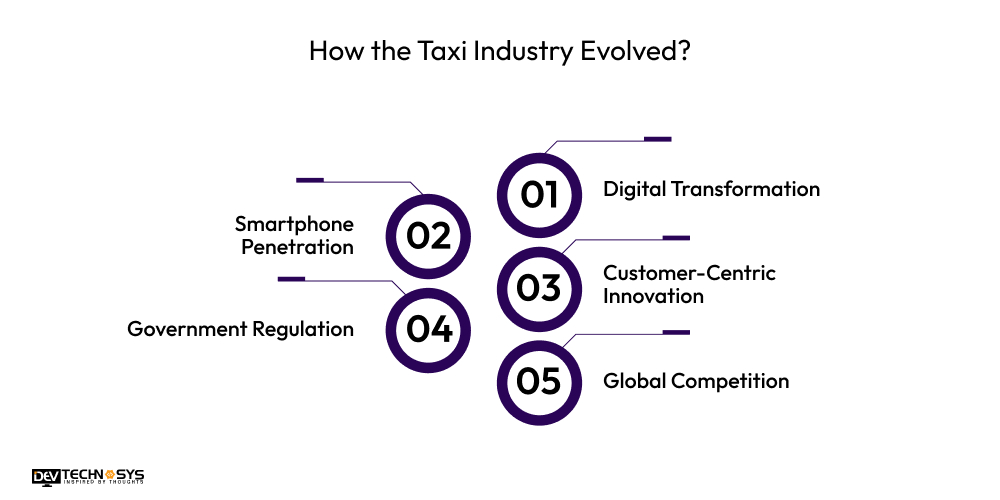
-
Digital Transformation
The user experience has changed as a result of the transition from manual booking methods to app-based platforms. You can develop a taxi app that is smarter and more efficient with features like digital payments, automatic dispatching, and real-time tracking.
-
Smartphone Penetration
The widespread availability of cellphones has greatly increased the accessibility and convenience of booking a taxi. Businesses can implement Android app development services, so users can schedule, monitor, and pay for rides. The number of ride-hailing apps has increased as a result of this shift.
-
Customer-Centric Innovation
By including services like ride reviews, fare estimates, and safety alerts, modern taxi platforms put the user experience first. The strong demand for taxi apps by commuters are met by customized services, loyalty plans, and various payment methods.
-
Government Regulation
Policies have been put in place by governments to increase driver accountability, passenger safety, and service quality. Taxi services are shaped by licensing regulations, pricing policies, and environmental requirements. A mobile app development company helps in getting certified government licence.
-
Global Competition
Market competitiveness has increased as a result of the emergence of global ride-hailing behemoths like Uber and Careem. Local operators have been compelled by this to innovate, lower prices, and improve the quality of their services. So, you can make a taxi app to beat the competition.
Top Emerging Trends in Taxi App Development
Innovations that increase user convenience are driving a rapid evolution in taxi app development. A number of innovative features are changing the way that taxi services are provided and used:
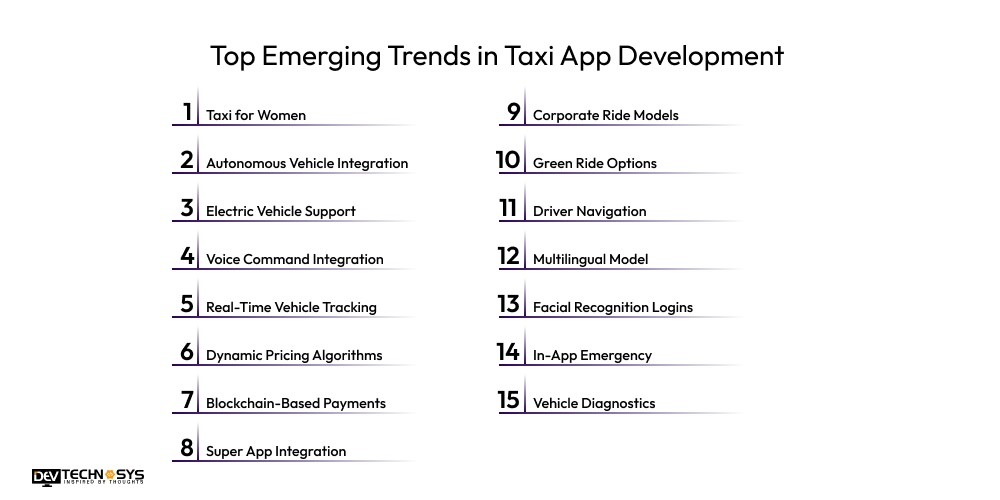
-
Taxi for Women
Women-only taxi services prioritize comfort and safety by using female drivers and safe, secure rides. These apps frequently have pre-verified accounts, real-time tracking, and SOS capabilities. Businesses can make a taxi app that is becoming more popular in cities with a varied population.
-
Autonomous Vehicle Integration
In order to create future, hands-free travel experiences, self-driving technology is being incorporated into taxi applications. You can develop a taxi app that will have minimum human involvement and projected arrival times. Autonomous taxis are already being tested in Dubai as part of its smart city initiatives.
-
Electric Vehicle Support
To promote sustainability, taxi applications are starting to offer the possibility to book electric vehicles. Features could include green ride labels, charging station information, and EV availability. By using taxi app development services you can lower emissions and promote environment-friendly transportation.
-
Voice Command Integration
Voice-enabled booking improves accessibility by enabling hands-free ride requests. Commands like setting destinations and requesting fare estimates are supported by this capability. In high-mobility environments, it is particularly helpful for drivers and people with disabilities.
-
Real-Time Vehicle Tracking
From pickup until drop-off, passengers can keep an eye on their transport thanks to live GPS monitoring. You can build a taxi app that offers precise ETA updates, improves safety, and boosts transparency. Real-time fleet monitoring is advantageous to administrators and users alike.
-
Dynamic Pricing Algorithms
Pricing driven by AI modifies fares according to availability, demand, and traffic. This balances supply and demand in real time and guarantees drivers receive fair compensation. In order to prevent customer annoyance, apps also clearly display fare increases.
-
Blockchain-Based Payments
Transactions in taxi apps are made safe, transparent, and impenetrable by blockchain technology. It can facilitate fraud protection, smart contracts for fare agreements, and cryptocurrency payments. For cities that are becoming more interested in Web3, invest in iOS app development in UAE.
-
Super App Integration
Payments, e-commerce, and food delivery are among the services that taxi apps are combining with. Convenience is increased when users may access several services on a single platform. The global rise of taxi app development solutions like Careem is reflected in this trend.
-
Corporate Ride Models
Employee ride accounts, spending monitoring, and monthly invoicing are examples of services that are beneficial to businesses. These apps make team mobility easier and provide professionals with high-end ride options. The future of taxi apps helps businesses to implement subscription-based pricing schemes.
-
Green Ride Options
Green ride filters allow environmentally aware consumers to select electric or low-emission automobiles. Apps may offer carbon offset programs and show carbon footprint savings. Businesses can create a taxi app for users to target sustainability goals that will find this appealing.
-
Driver Navigation
Real-time traffic updates, suggested detours, and optimized routes are all provided by built-in maps. Passenger wait times, fuel expenses, and travel duration are all decreased as a result. AI and navigation are frequently used by a taxi app development company to provide predicted rerouting.
-
Multilingual Model
In multicultural cities like Dubai, taxi apps have multilingual user interfaces. For greater accessibility, this covers Arabic, English, Hindi, Tagalog, and other languages. To enhance the user experience, voice and written instructions are localized.
-
Facial Recognition Logins
App security is improved by biometric login features like facial recognition. It guarantees that their profiles are only accessed by drivers and authorized users. Additionally, this improves user ease by streamlining the login procedure.
-
In-App Emergency
In dangerous circumstances, SOS buttons link users to emergency contacts or services. Instantaneous location sharing, panic warnings, and incident reporting are activated. In contemporary taxi applications, it is an essential safety element.
-
Vehicle Diagnostics
IoT-powered diagnostic tools keep an eye on the condition of vehicles and alert drivers to problems. Taxi apps can notify administrators or drivers about performance metrics and maintenance requirements. This increases the cost to maintain an app and lowers failure rates that guarantees safety.
Leading Taxi Brands in Dubai
Dubai has top taxi brands that provide cutting-edge, dependable, and user-friendly transportation services. You can build a successful taxi app for locals and visitors by following the below taxi business models:
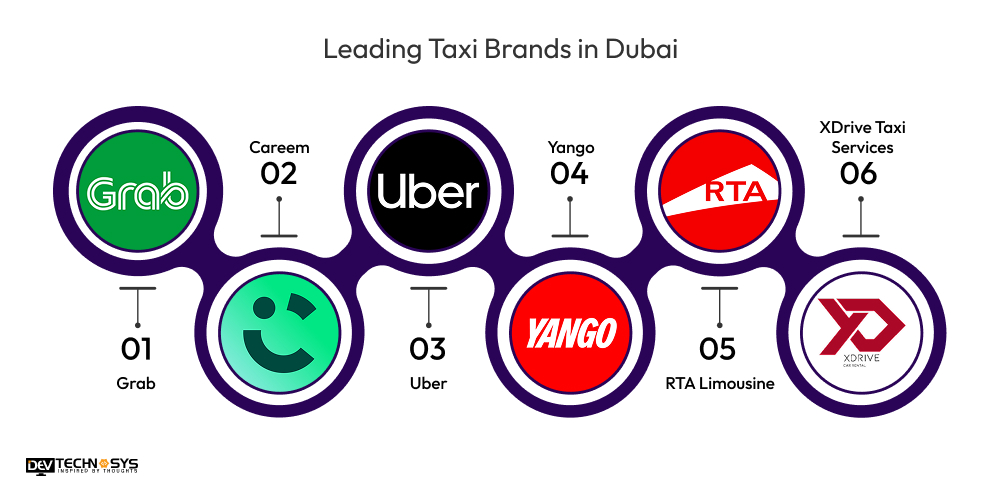
1. Grab
Through key alliances, Grab has expanded its services internationally since its initial introduction in Southeast Asia. Through its super app approach, it links consumers to local chauffeur and taxi services in Dubai. It provides digital payment methods, meal delivery, and ride-hailing all on one platform.
- Multi-Service Super App
- Localized Partnerships
2. Careem
Businesses can create a taxi app like Careem that is now utilized extensively around the Middle East. It provides food delivery, bike rentals, ride-hailing, and even interstate travel. Careem is renowned for its corporate transportation programs, safety features, and regional personalization.
- Real-Time Ride Tracking
- In-App Wallet
3. Uber
Uber offers a variety of trip options in Dubai like premium cars, UberX, and UberXL. Additionally, you can build a taxi app with features like ride-sharing choices, driver ratings, and pricing. For a smooth mobility experience, the app also connects with public transportation.
- Fare Transparency
- Driver & Vehicle Ratings
4. Yango
Yango, a division of the Russian IT behemoth Yandex, offers AI-powered taxi dispatching in Dubai. It provides real-time tracking with route optimization, multilingual support, and competitive price. Yango is growing its footprint in the Gulf area and focuses on tech-driven efficiency.
- AI-Based Route Optimization
- Multilingual App Interface
5. RTA Limousine
A government-approved luxury taxi app like RTA Dubai is run by Dubai’s Roads and Transport Authority. It offers premium transportation choices for VIPs and airports that are pre-booked. It is a popular option for business travel and is renowned for its dependability and professionalism.
- Premium Fleet Selection
- Pre-Booking Facility
6. XDrive Taxi Services
XDrive is a new taxi service in Dubai that offers reasonably priced transportation options. It appeals to everyday commuters with its emphasis on spotless cars, customer service, and online reservations. For a seamless rider experience, XDrive prioritizes safety, speedy pickups, and simple app use.
- Eco-Friendly Vehicles
- Flexible Payment Options
Key Features of Taxi Booking Apps
A good taxi booking software has separate panels for users, drivers, and administrators. Every panel has special features intended to improve user experience, streamline ride management, and optimize routes:
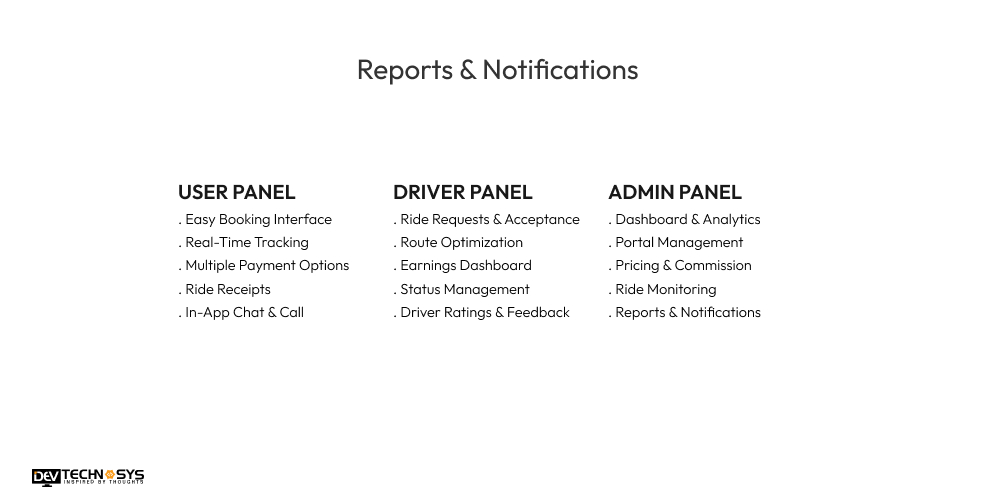
User Panel
-
Easy Booking Interface
Users can quickly book rides by selecting pickup and drop-off locations. You can build a taxi app with intuitive navigation and minimal input steps.
-
Real-Time Tracking
Live GPS tracking allows users to monitor their ride location, estimated arrival time, and route in real-time.
-
Multiple Payment Options
An app like Hala Taxi supports various payment modes including credit/debit cards, digital wallets, and cash for maximum convenience.
-
Ride Receipts
After every trip, users receive a digital receipt detailing fare breakdown, distance covered, and payment mode.
-
In-App Chat & Call
Users can directly communicate with drivers through in-app messaging or calling for coordination and support.
Driver Panel
-
Ride Requests & Acceptance
Drivers receive instant ride requests with trip details and can accept or reject them based on their availability.
-
Route Optimization
Smart navigation tools provide the fastest, traffic-free routes to enhance fuel efficiency and reduce trip time.
-
Earnings Dashboard
An app like TaxiF allows drivers to view their daily, weekly, and monthly earnings along with completed rides and tips in one place.
-
Status Management
You can create a taxi app that allows drivers to toggle between online and offline modes to manage their working hours effectively.
-
Driver Ratings & Feedback
A taxi booking app allows drivers to view passenger ratings and feedback, helping them improve service quality and maintain standards.
Admin Panel
-
Dashboard & Analytics
A centralized dashboard displays real-time data on users, drivers, rides, and revenue through easy-to-read analytics.
-
Portal Management
Admins can manage app content, user access, vehicle categories, and user-driver profiles. So, you can make a taxi app from a single interface.
-
Pricing & Commission
An app like Bolt allows flexible control over fare structures, surge pricing, discounts, and commission settings for drivers.
-
Ride Monitoring
Admins can track all active rides, monitor unusual activity, and resolve disputes in real-time for safety and reliability.
-
Reports & Notifications
Admins generate detailed reports and send alerts or push notifications to users and drivers for updates and announcements.
Latest Technologies Enhancing Taxi Business
Emerging technologies that improve user data efficiency are revolutionizing taxi app development. These developments from transactions to predictive algorithms, are changing contemporary cab solutions:
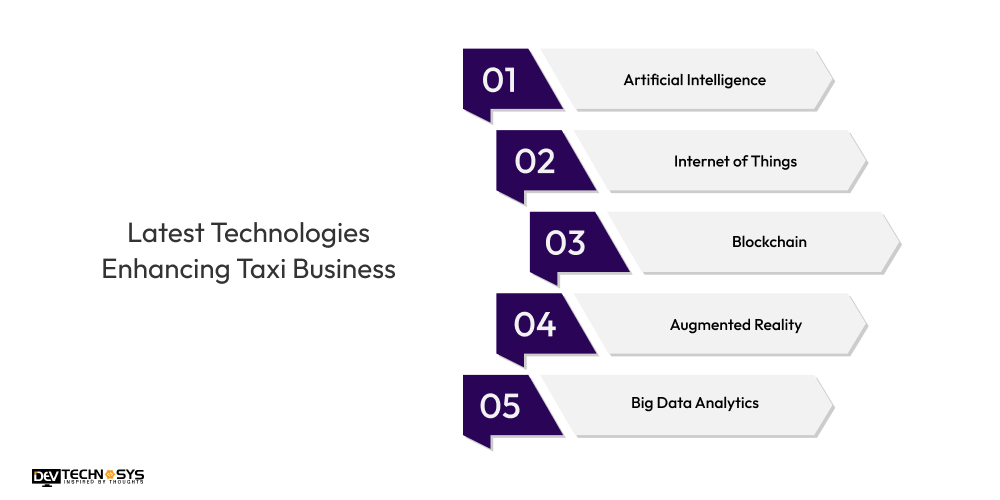
-
Artificial Intelligence
Based on user behavior, AI is utilized to optimize routes, forecast demand, and customize ride experiences. It drives driver-performance data, chatbot-based customer service, and dynamic pricing. So, you can make a taxi app with AI that enhances operational effectiveness and decision-making.
-
Internet of Things
IoT links automobiles to electronic devices to track data in real time, such as engine health, speed, and fuel levels. An app like Maxim increases passenger safety, decreases downtime, and uses predictive maintenance. For improved control, IoT also facilitates geofencing and real-time fleet tracking.
-
Blockchain
Blockchain improves ride logs, driver records, and payment security and transparency. Fare settlements are automated via smart contracts, and tampering is prevented by decentralized data storage. When it comes to fostering confidence in multi-party transactions, develop a taxi app with blockchain.
-
Augmented Reality
AR helps drivers and users by providing location-based graphics for vehicle identification, route advice, and pick-up locations. It can improve in-app navigation by reducing the cost to develop a mobile app in the UAE. AR makes the experience more interesting by introducing a layer of interactivity.
-
Big Data Analytics
Big data facilitates strategic decision-making by analyzing driver performance, peak demand areas, and user behavior. Improved client retention, optimal driver deployment, and tailored offers are made possible by it. Future business planning and risk assessment are also aided by analytics.
Challenges in Implementing Trending Taxi Solutions
Contemporary technologies are revolutionizing the cab sector, but there are various challenges to develop a taxi app. To achieve seamless, future-ready operations, businesses must overcome these challenges:

-
Regulatory Compliance
Businesses can build a taxi app that comply with city-specific transportation laws, safety regulations, and licensing requirements. Penalties, service limitations, or app bans may follow noncompliance.
Solution: To guarantee continued legal alignment and policy adaptation, collaborate closely with local authorities.
-
High Infrastructure Costs
The cost to develop a taxi booking app is high due to integration of IoT technology. These expenses may be prohibitive, particularly for small and medium-sized businesses.
Solution: To cut costs, start with scalable prototype projects and look for government funds or collaborations.
-
User Trust in Automation
Concerns about privacy and safety may make passengers hesitant to utilize self-driving taxis. Resistance is increased by ignorance of taxi app development services and user experience.
Solution: To foster confidence, provide test rides, show safety documentation, and maintain open lines of communication.
-
Tech Integration Issues
Performance problems may arise when old systems are combined with new technologies like blockchain. Delays, errors, or data inconsistencies impact the motive to invest in a taxi app.
Solution: Make use of modular, API-first architectures to facilitate seamless system scalability and integration.
Final Thoughts!!
We have seen various taxi app development trends in this blog that help businesses to easily build a taxi app for growth and revenue generation. As a business investor, you can hire a taxi app development company at reasonable prices to avail standard services for developing taxi booking solutions. Follow below steps to prevent financial losses:
- Examine various business models and list important features.
- List your requirements and start the development.
- Keep a flexible budget for launch and maintenance costs.
- Implement suitable monetization methods.
These points are necessary for an entrepreneur to make a successful brand without compromising with the budget. Additionally, they will also help in making huge profit through high user engagement.
FAQs
1. What are the Key Trends for Taxi App Development in 2025?
- Real-time route optimization.
- Integration of EV fleets and autonomous taxis.
- Taxi apps offer food delivery.
2. How is Dubai Supporting the Evolution of Taxi Apps?
Dubai is making significant investments in digital mobility projects and smart city infrastructure. The RTA tests new technologies, including EVs and driverless taxis, in partnership with private companies. Incentives and regulations are also in place to promote transportation models driven by technology.
3. Will Autonomous Taxis Become Common in Dubai by 2025?
Through collaborations like Cruise and RTA, Dubai has already started conducting autonomous car pilot tests. Although widespread adoption might take longer, substantial advancements are anticipated by 2025. Anticipate a small but significant rollout in a few smart zones and tourism destinations.
4. How Can Taxi Apps Contribute to Sustainability in Dubai?
By encouraging ride-sharing and incorporating electric car options, taxi applications can contribute to sustainability. Emissions are decreased with features like carbon tracking, eco-friendly route preferences, and efficient routing. These initiatives support Dubai’s long-term goals for zero emissions and green mobility.
5. What Challenges do Developers Face when Creating Taxi Apps for Dubai’s market?
- RTA standards and data privacy regulations.
- Technologies like IoT, blockchain, and AI.
- Diverse languages, cultures, and accessibility in Dubai.



